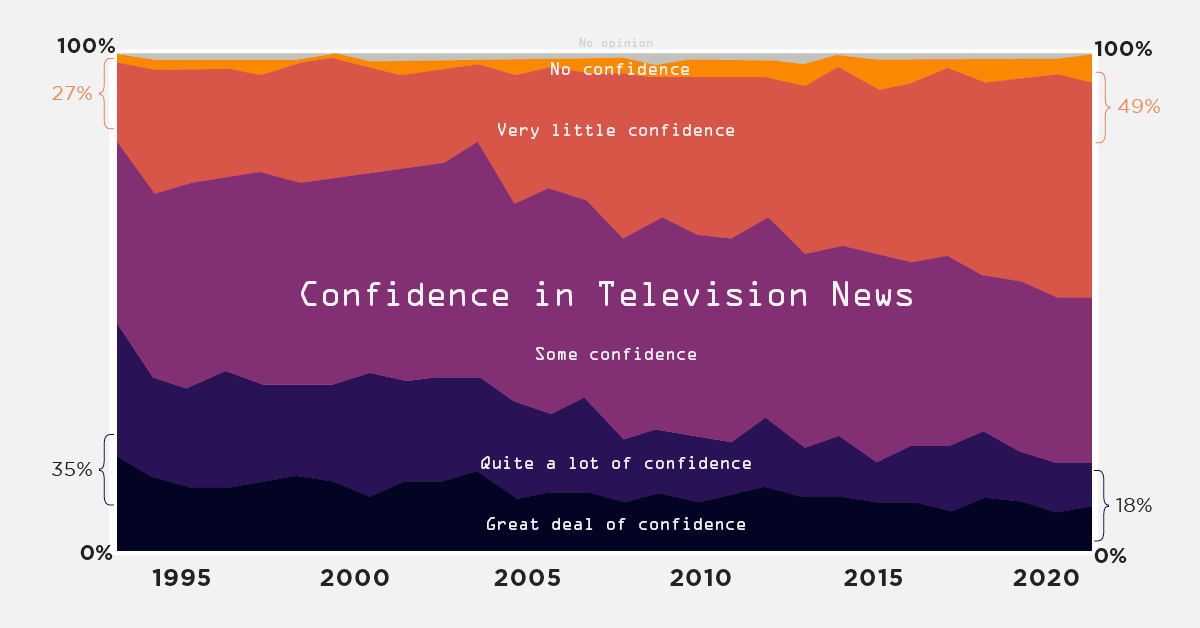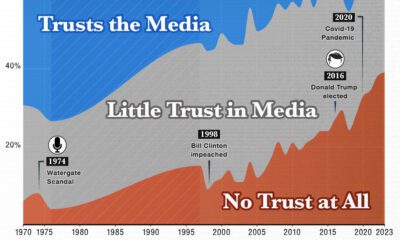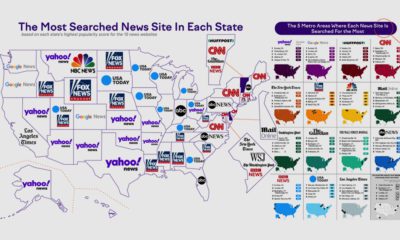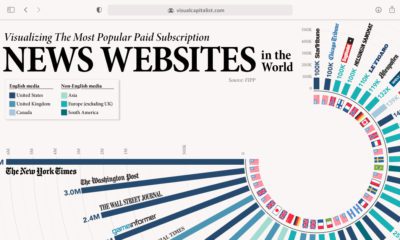Datastream
Trust in TV News Media Continues its Steep Decline in the U.S.
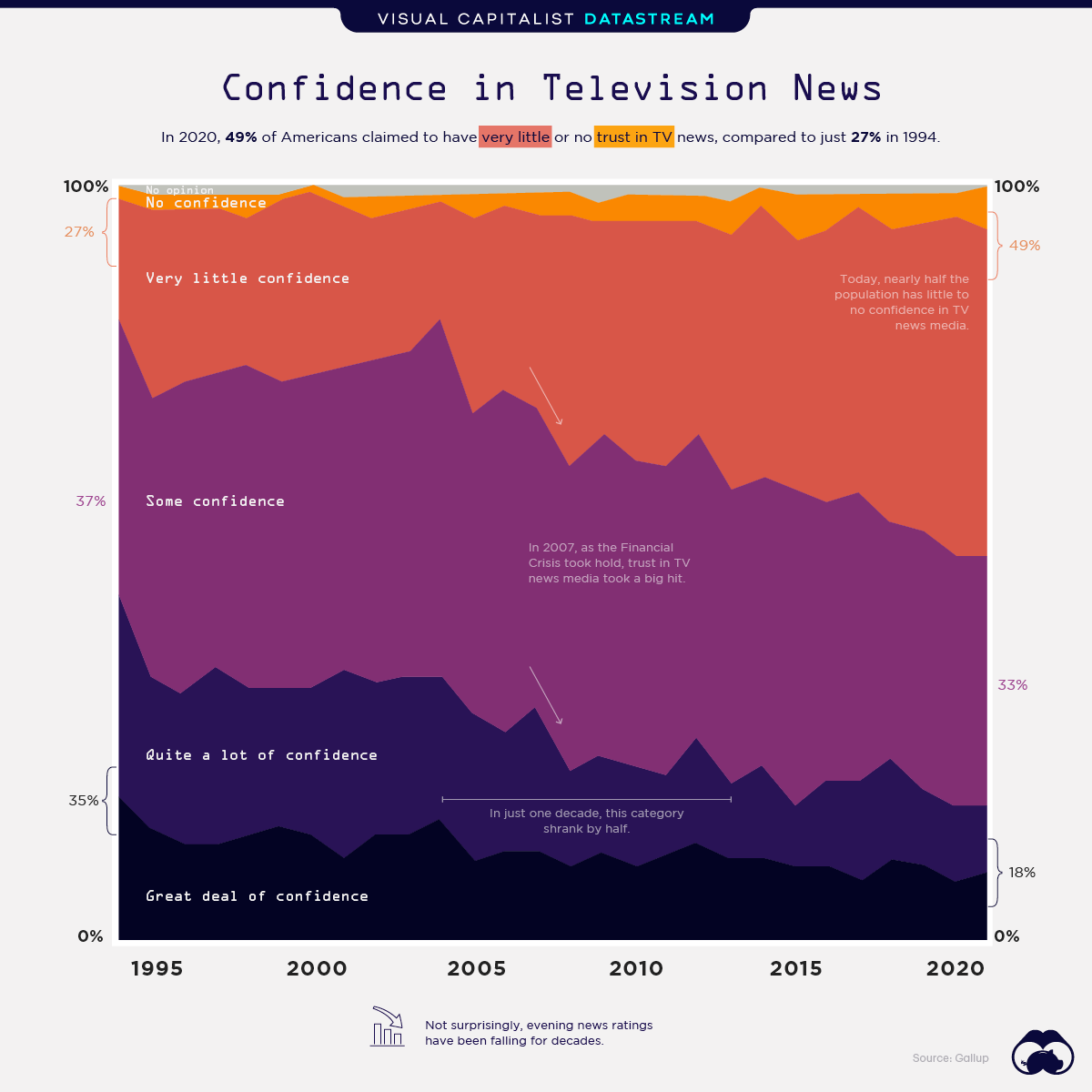
The Briefing
- In 1994, 35% of consumers had a “great deal” or “quite a lot” of trust in TV news
- In 2020, only 18% feel the same way
- Unsurprisingly, younger Americans are more skeptical than older Americans
Trust in TV News has Dropped Among U.S. Consumers
Americans are increasingly losing their trust in traditional institutions, particularly when it comes to TV news.
In 2020, a whopping 49% of U.S. consumers claim to have very little or no trust in TV news, compared to just 27% in 1994:
| Year | A lot of Trust (%) | Some Trust (%) | Very Little/ No Trust (%) |
|---|---|---|---|
| 1994 | 35 | 37 | 27 |
| 1996 | 36 | 39 | 24 |
| 1998 | 34 | 40 | 25 |
| 2000 | 36 | 40 | 23 |
| 2002 | 35 | 43 | 21 |
| 2004 | 30 | 40 | 29 |
| 2006 | 31 | 40 | 28 |
| 2008 | 24 | 43 | 31 |
| 2010 | 22 | 41 | 36 |
| 2012 | 21 | 39 | 38 |
| 2014 | 18 | 42 | 39 |
| 2016 | 21 | 38 | 40 |
| 2018 | 20 | 34 | 45 |
| 2020 | 18 | 33 | 49 |
Why Is TV News Losing Credibility?
What’s causing this loss of trust? A recent report by Knight Foundation and Gallup surveyed 20,000 U.S. adults to find out. Based on the responses, the survey found that:
- Too Much Bias
A majority of Americans see “a great deal” of political bias in news coverage (46%). - A Hidden Agenda
Americans believe news outlets have a hidden agenda, and inaccurate reporting is intentional — 52% believe reporters will misrepresent facts on purpose. - Younger Americans are More Skeptical
43% of Americans aged 65+ have favorable views towards media, while only 20% of Americans under 30 years feel the same way.
Despite these hesitations, a majority of Americans still believe news is a critical part of a democratic society.
On this note, 82% see news as a tool that holds leaders accountable for their actions, and 88% feel the news is an essential way to keep Americans informed about public affairs.
So, it’s clear that the news, in theory, is valued. It’s just not meeting the expectations of Americans in practice.
» Interested in the news media landscape? You may enjoy this full article, Who Owns Your Favorite News Media Outlet?
Where does this data come from?
Source: Gallup Poll, “Confidence in Institutions”
Note: Percentages in the table may not add up to 100% due to rounding, for clarity
Datastream
Can You Calculate Your Daily Carbon Footprint?
Discover how the average person’s carbon footprint impacts the environment and learn how carbon credits can offset your carbon footprint.

The Briefing
- A person’s carbon footprint is substantial, with activities such as food consumption creating as much as 4,500 g of CO₂ emissions daily.
- By purchasing carbon credits from Carbon Streaming Corporation, you can offset your own emissions and fund positive climate action.
Your Everyday Carbon Footprint
While many large businesses and countries have committed to net-zero goals, it is essential to acknowledge that your everyday activities also contribute to global emissions.
In this graphic, sponsored by Carbon Streaming Corporation, we will explore how the choices we make and the products we use have a profound impact on our carbon footprint.
Carbon Emissions by Activity
Here are some of the daily activities and products of the average person and their carbon footprint, according to Clever Carbon.
| Household Activities & Products | CO2 Emissions (g) |
|---|---|
| 💡 Standard Light Bulb (100 watts, four hours) | 172 g |
| 📱 Mobile Phone Use (195 minutes per day)* | 189 g |
| 👕 Washing Machine (0.63 kWh) | 275 g |
| 🔥 Electric Oven (1.56 kWh) | 675 g |
| ♨️ Tumble Dryer (2.5 kWh) | 1,000 g |
| 🧻 Toilet Roll (2 ply) | 1,300 g |
| 🚿 Hot Shower (10 mins) | 2,000 g |
| 🚙 Daily Commute (one hour, by car) | 3,360 g |
| 🍽️ Average Daily Food Consumption (three meals of 600 calories) | 4,500 g |
| *Phone use based on yearly use of 69kg per the source, Reboxed | |
Your choice of transportation plays a crucial role in determining your carbon footprint. For instance, a 15 km daily commute to work on public transport generates an average of 1,464 g of CO₂ emissions. Compared to 3,360 g—twice the volume for a journey the same length by car.
By opting for more sustainable modes of transport, such as cycling, walking, or public transportation, you can significantly reduce your carbon footprint.
Addressing Your Carbon Footprint
One way to compensate for your emissions is by purchasing high-quality carbon credits.
Carbon credits are used to help fund projects that avoid, reduce or remove CO₂ emissions. This includes nature-based solutions such as reforestation and improved forest management, or technology-based solutions such as the production of biochar and carbon capture and storage (CCS).
While carbon credits offer a potential solution for individuals to help reduce global emissions, public awareness remains a significant challenge. A BCG-Patch survey revealed that only 34% of U.S. consumers are familiar with carbon credits, and only 3% have purchased them in the past.
About Carbon Streaming
By financing the creation or expansion of carbon projects, Carbon Streaming Corporation secures the rights to future carbon credits generated by these sustainable projects. You can then purchase these carbon credits to help fund climate solutions around the world and compensate for your own emissions.
Ready to get involved?
>> Learn more about purchasing carbon credits at Carbon Streaming
-

 Mining1 week ago
Mining1 week agoGold vs. S&P 500: Which Has Grown More Over Five Years?
-

 Markets2 weeks ago
Markets2 weeks agoRanked: The Most Valuable Housing Markets in America
-

 Money2 weeks ago
Money2 weeks agoWhich States Have the Highest Minimum Wage in America?
-

 AI2 weeks ago
AI2 weeks agoRanked: Semiconductor Companies by Industry Revenue Share
-

 Markets2 weeks ago
Markets2 weeks agoRanked: The World’s Top Flight Routes, by Revenue
-

 Countries2 weeks ago
Countries2 weeks agoPopulation Projections: The World’s 6 Largest Countries in 2075
-

 Markets2 weeks ago
Markets2 weeks agoThe Top 10 States by Real GDP Growth in 2023
-

 Demographics2 weeks ago
Demographics2 weeks agoThe Smallest Gender Wage Gaps in OECD Countries
